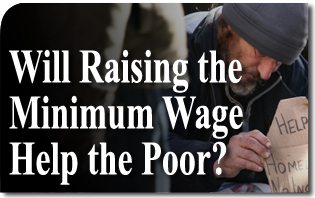
With a law set to raise the minimum wage from $8 to $15 an hour, Seattle begins its journey to help those who are impoverished while stimulating its economy at the same time. On the surface this appears to be a win-win situation that only the ignorant and hard-hearted could condemn.
Indeed, liberal proponents point out the benefits of this law by claiming there will be no ill effects to the normal activity where “some businesses are closing while others are opening” in what they allege to be a thriving economy. They further claim that there are “studies that show that raising the minimum wage can only be good.” This all sounds excellent, but is it the complete story?
As with most considerations of an economic matter, this one is particularly complex. First of all, the money Seattle “gains” from the increase will not actually be added to the local economy. The declaration that increasing the minimum wage will stimulate an economy is but a warm and fuzzy liberal statement. Taking money that is already part of an economy and redistributing it to another stimulates nothing.
Ironically, even the government money, which the liberals love to distribute, will be lost to the Seattle economy. As low wage earners move from earning $8 to $15 per hour, they will pay additional money in higher income tax; lose earned income tax credits and welfare subsidies. These additional financial responsibilities represent a substantial setback to the lowest quintile wage earner. Welfare money that was once part of Seattle’s economy will now be paid by those most in need of assistance to the Federal government to be spent elsewhere, not Seattle.
From the business point of view, the increase also creates problems. According to the U.S. Census Bureau, there are 6 million employer firms in the U.S., of which 5.4 million, or 90 percent, that employ less than 20 people.1 Many of these small businesses, such as restaurants, employ low-skilled labor and cannot absorb a substantial wage increase without dramatically affecting the bottom line. This problem is made worse by the fact that labor represents a disproportionally large part of their operating costs.
Anthony Anton from the Washington Restaurant Association sums things up like this: “It’s not a political problem; it’s a math problem.” He estimates the average budget breakdown among profitable Seattle restaurants as follows: “Thirty-six percent of funds are devoted to labor, 30 percent to food costs and 30 percent go to everything else, all other operational costs. The remaining 4 percent has been the profit margin, and as a result, in a $700,000 restaurant, he estimates that the average restaurateur in Seattle has been making $28,000 a year.”2
This analysis indicates that restaurant labor costs would increase from approximately 36 percent of total income to somewhere between 42 to 47 percent. Raising the minimum wage to $15 will result in an increase of 6 to 11 percent of gross receipts to be absorbed from the 4 percent profit margin of today’s average restaurant. That means operating at a 2 to 7 percent deficit with no changes to operations.
To solve the problem, the options are to automate, increase prices, lower the quality of materials, cut workers hours, fire employees or go out of business. None of these come across as appealing to any business, especially one that is operating on a 4 percent profit margin already.
The restaurant sector is just one example of the many industries that will be severely impacted by the wage increase. Companies that are involved in production that utilizes low skilled labor will face a similar financial squeeze. Such firms will find it more economical to supplant low and medium skilled labor with machines and automation in order to turn a profit.
One such example of how increasing low skilled wages leads to an increase in automation can be seen in McDonalds’ European operation. McDonald’s was forced to automate in order to cut expenses because of high labor costs caused by similar social reforms. To combat these one-sided laws, they installed automated ordering and cashier machines in over 7,000 locations.3
Let’s do some simple math. With a fast food restaurant open 24 hours per day, the cost of human cashier position at $15 per hour X 24 hours per day X 365 days per year = $131,400 for one employee position. (obviously shared by several employees) It does not including the cost of benefits, unemployment insurance, worker’s compensation, FICA taxes or administrative costs for the employees filling this position. A similar position at locations open 18 hours per day would be $98,550.
This, in order to be cost effective, an automated device needs to cost less than $100,000 per year to purchase and maintain. Furthermore, a machine does not need health care, vacation time, raises, paid holidays, nor can it call in sick or quit when it is not happy. Increasing labor costs will simply raise a company’s incentive to adopt automated technology.
In reality, those businesses least able to pay higher wages will be forced to fire those least able to find comparable work. Raising the national minimum wage will effectively do great harm to the majority of small businesses across the country, which need policies favoring growth, not more asphyxiating socialized policy written by bureaucrats attempting to control every aspect of life.
Unfortunately, the penchant for implementing poorly thought out socialist policies like the minimum wage increase, hurts both the most vulnerable and the business community. In this lesson, Seattle will soon realize this “win-win” situation will not deliver.
The image used is “The Forgotten Man” by Alex Proimos and is licensed under CC BY 2.0

